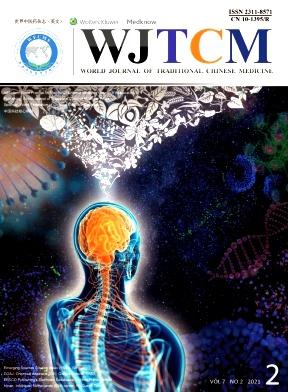Study on the mechanism and molecular docking verification of buyang huanwu decoction in treating diabetic foot
IF 3.2
3区 医学
Q1 INTEGRATIVE & COMPLEMENTARY MEDICINE
引用次数: 1
Abstract
Objective: The objective of this study was to investigate the molecular mechanism of Buyang Huanwu decoction (BYHWD) in the treatment of diabetic foot (DF). Methods: The TCMSP, BATMAN, PubChem, PharmMapper, UniProt, GeneCards, Webgestalt, and Kobas databases were used to obtain the structures, targets, main biological functions, and pathways of the active ingredients of BYHWD, and the results were visualized using Cytoscape3.6.1, Ledock, and PyMol software. Results: A total of 82 active components of BYHWD and 193 targets related to BYHWD were identified, and 5295 genes related to DF were identified using the GeneCards database, including 65 key targets of BYHWD in the treatment of DF. GO and KEGG enrichment analyses of the 65 targets for BYHWD treatment of DF showed that 47 GO items were involved in the treatment. It was mainly involved in biological processes, such as biological regulation, metabolism, and stress response. It is primarily involved in protein binding, ion binding, nucleotide binding, and other molecular functions. It is mainly involved in membrane encapsulation, membrane lumen closure, and other biological components and involved in the VEGF, TNF, RAS, RAP1, PI3K-AKT, MAPK, and IL-17 signaling pathways. Most targets were enriched in the PI3K-AKT and MAPK signaling pathways. Molecular docking results showed that the 59 key active components of BYHWD had strong binding activity with 64 key DF targets. Conclusion: The therapeutic effect of BYHWD on DF is based on the pharmacological effects of multiple targets and pathways.补阳还五汤治疗糖尿病足的作用机制及分子对接验证研究
目的:探讨补阳还五汤治疗糖尿病足的分子机制。方法:利用TCMSP、BATMAN、PubChem、PharmMapper、UniProt、GeneCards、Webgesalt和Kobas数据库,获得BYHWD活性成分的结构、靶标、主要生物学功能和途径,并使用Cytoscape3.6.1、Ledock和PyMol软件对结果进行可视化。结果:利用GeneCards数据库共鉴定出BYHWD的82个活性成分和193个与BYHWD相关的靶点,并鉴定出5295个与DF相关的基因,其中BYHWD治疗DF的65个关键靶点。对BYHWD治疗DF的65个靶点的GO和KEGG富集分析表明,该治疗涉及47个GO项目。它主要参与生物过程,如生物调节、代谢和应激反应。它主要参与蛋白质结合、离子结合、核苷酸结合和其他分子功能。它主要参与膜包封、膜腔封闭和其他生物成分,并参与VEGF、TNF、RAS、RAP1、PI3K-AKT、MAPK和IL-17信号通路。大多数靶标在PI3K-AKT和MAPK信号通路中富集。分子对接结果表明,BYHWD的59个关键活性成分与64个关键DF靶点具有较强的结合活性。结论:BYHWD对DF的治疗作用是基于多靶点、多途径的药理作用。
本文章由计算机程序翻译,如有差异,请以英文原文为准。
求助全文
约1分钟内获得全文
求助全文
来源期刊

World Journal of Traditional Chinese Medicine
Medicine-Complementary and Alternative Medicine
CiteScore
5.40
自引率
2.30%
发文量
259
审稿时长
24 weeks
 求助内容:
求助内容: 应助结果提醒方式:
应助结果提醒方式:


